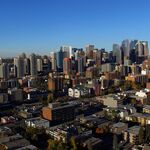Profit maximization assumes that the service would be profitable at any point; otherwise it sounds like the joke about someone losing $5 on every sale but making it up with volume. That said, I don't think that profit is a good motive for a public transportation system; it would be nice if there was limited subsidy for operations (iignoring the tens of billions of subsidy for construction), but public services are worth something.
In any case.. does "provide as much service as possible with a low cost to users" sound like something this government intends to do about anything (where the users are not oil company CEOs)?
The quietest sections of Highway 2 are around 22000 vehicles per day (S of highway 53 by Ponoka). Of those vehicles, only 77% are passenger cars, which is 17K vehicles two-way. The
TEMS report ca. 2006 that
darwink linked to earlier assumes 2 people per vehicle average, so that's 17K person trips each way. The report concluded that at top speed, HSR could capture 7% of the volume. That's around 1200 people per day, each way at maximum load. (In fact, if half the corridor volume is Calgary to Edmonton and half the volume is Calgary-Red Deer and Edmonton-Red Deer, it's actually 1600 person trips, with 400 getting off and 400 getting on in Red Deer). A typical new TGV train has a capacity of 500 people depending on the specific vehicle configuration. If the peak rail demand is less than 3 full trains a day in each direction, why would we expect 5 times as many trains to be run? (The rub is that the 7% mode share was assuming 17 trains per day, which means that trains would be running 85% empty. Or that fewer trains would run, reducing the mode share further.)
I was wondering about AADT on the highway, and how it's changed since 2006; luckily, it's not that hard to find and to plot in the same way on the same axes (in red, with grids in white):
View attachment 614829
What's interesting is there are some areas with really substantial growth; in the approaches to Calgary (the peak at 150K is the same; Deerfoot between McKnight and Glenmore was full in 2006 and remains full today), the approach to Edmonton from the south, as well as from north of Red Deer into town. But there's much less growth on the true inter-city portion that HSR is intended to serve; the 2023 volume is up from 20 to 22K at Lacombe, from 20 to 24K at Wetaskiwin (km 491) and Olds (km 351); it's actually lower at the Red Deer bypass at Taylor Drive, only 20K today.
The TEMS report had forecasts of total car volumes in the corridor; I've added an indication of what those might look like in orange (interpolating the 2021 and 2026 forecasts); we're less than halfway there, and much less at the lowest volume points -- and by definition all through traffic that might take HSR passes through these low points. This is despite the population growth to 2021 exceeding the medium forecast; in Edmonton by 11% and in Calgary by 19% (2% low in Red Deer). Volume is nowhere near the forecast. It's a lot easier to justify HSR if you double or triple the potential market size.





